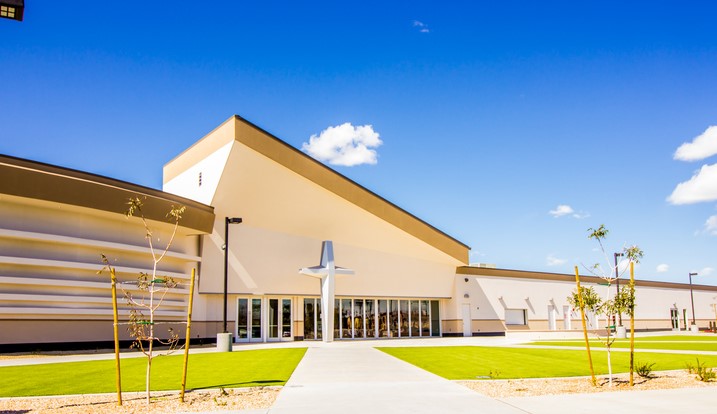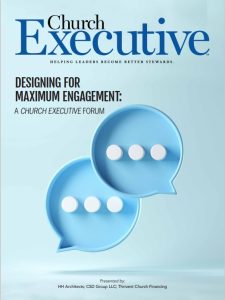
 An experienced church architect discusses what “engaging design” really means — and it’s a lot more than bricks-and-mortar
An experienced church architect discusses what “engaging design” really means — and it’s a lot more than bricks-and-mortar

President & CEO
HH Architects
(Dallas)
Church Executive: The topic of “designing for maximum engagement” is top of mind for you and your team. Why?
Bruce Woody: During COVID, there was such a period of disengagement. Church leaders demonstrated their flexibility by shifting quickly from in person service to online services. Now, the importance of reengaging and maximizing time with guests, visitors and members is crucial. We are starting to see church leaders are ready to engage and get everybody back into a sense of worship and fellowship on campus. The current trend reflects that people desire to be in-person and fully engaged as families. Certainly, churches prefer this.
CE: Have you seen engaging design strategies change in the aftermath of COVID?
Woody: There has been a tremendous focus on a sense of hospitality and churches are meeting those expectations, not just for existing members but for new members who might have worshipped online and are just now coming to the campus for the first time. One simple example has been offering outdoor fellowship spaces.
CE: Right; it does seem like COVID would spotlight the need for outdoor gathering spots.
Woody: Yeah, for a long time, churches dismissed outdoor spaces, but HH Architects has been designing them for years. There was a period of time that these spaces were eliminated from designs due to cost, but now church leaders are seeing the value that outdoor space brings to the church.
CE: When we use the term “engaging design,” when should that experience start — and end?
Woody: Most people searching for a new church will first search online. Therefore, the church website needs to have an impactful first impression that clearly provides the overall style of the church (ideally carries over into the design of the church building(s)). Online, a church promotes fellowship and engagement. If a visitor arrives at the campus and the building is not reflective of the church website, it’s sending a mixed message.
The church buildings should ensure a welcoming and intuitive experience. Outdoor spaces (parking and pedestrian outdoor spaces) should connect naturally to navigate to the building(s) for people. The church campus layout needs to provide a sense of warmth, safety, security — all these are key to a design that families will experience these essential elements.
Most people searching for a new church will first search online. Therefore, the church website needs to have an impactful first impression that clearly provides the overall style of the church (ideally carries over into the design of the church building(s)).
CE: These days, is it accurate to say that engaging design means people feel welcome on campus all week long?
Woody: Yes. We’ve been seeing this for the last couple of generations. Church has changed over the years, from a weekend experience to providing more opportunities to the congregation to participate with their communities.
The current generation of church leadership encourages involvement from all age groups to interact versus being segmented into activities for adults, senior adults, youth and so on. They desire to see all ethnicities and cultures together, enjoying family activities in hospitality-focused spaces on campus.
CE: A church’s culture, or DNA, plays a big part in its design. But are there also universally engaging design principles?

Woody: Again, it starts with hospitality. Today’s culture anticipates an experience, whether they’re going to a movie, to a restaurant, or to church. It should be very welcoming, positive and uplifting. If your church doesn’t have large common gathering areas, it can’t really facilitate hospitality because there’s no space to do it. It’s equally important that every space has a design, an intent and a purpose, regardless of age group. Careful considerations need to be made when designing the campus layout to ensure that all aspects are planned during the design process.
CE: How have you ensured engaging design in smaller churches, or those on a limited budget?
Woody: Regardless of church size all these principles apply. If the building looks unprepared for visitors, or if church leadership is constantly apologizing for a lack of facilities (or for the state they’re in), you’re sending a clear message of lacking coherence. Again, people are looking for an experience that meets or even exceeds their expectations. To sum it up: whatever you do, do it to the best of your abilities. Whatever you can do, do it well.
CE: What about multisite locations? Do engaging design strategies differ in these spaces?
Woody: No, they’re the same. It’s even more crucial that these locations all send the same message. The design should deflect church attendees from having different experiences based on locations. Otherwise, a person might have the opinion, that the church really doesn’t place the same priority on their other campuses like they do the home church. Across the board, it’s important that the strategy, the messaging — all of it — is universal.
— Reporting by RaeAnn Slaybaugh


